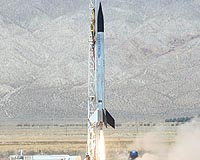 |
Livermore CA (SPX) May 17, 2010 Understanding the key elements of biofuel combustion is an important step toward insightful selection of next-generation alternative fuels. And that's exactly what Lawrence Livermore and Sandia national laboratories researchers intend to do. In a new paper on the cover of the May 10 edition of the journal Angewandte Chemie, Sandia researcher Nils Hansen and Lawrence Livermore scientist Charles Westbrook take a look at the vastly diverse and complex chemical reaction networks of biofuel combustion. The paper, "Biofuel Combustion Chemistry: From Ethanol to Biodiesel," examines the combustion chemistry of those compounds that constitute typical biofuels, including alcohols, ethers and esters. Biofuels such as bioethanol, biobutanol and biodiesel are of increasing interest as alternatives to petroleum-based transportation fuels. According to Hansen and Westbrook, however, little research has been done on the vastly diverse and complex chemical reaction networks of biofuel combustion. In general, the term biofuel is associated with only a few select chemical compounds, especially ethanol (used exclusively as a gasoline replacement in spark-ignition engines) and very large methyl esters in biodiesel (used as a diesel fuel replacement in diesel engines). The biofuels are oxygenated fuels, which distinguishes them from hydrocarbons in conventional petroleum-based fuels. While much discussion surrounding biofuels has emphasized the process to make these alternative fuels and fuel additives, Hansen and Westbrook for the first time examined the characteristic aspects of the chemical pathways in the combustion of potential biofuels. In collaboration with an international research team representing Germany, China and the United States, Westbrook, Hansen and former Sandia post-doctoral student Tina Kasper used a unique combination of laser spectroscopy, mass spectrometry and flame chemistry modeling to explore the decomposition and oxidation mechanisms of certain biofuels and the formation of harmful or toxic emissions. "To understand the associated combustion reactions and to identify recurring reaction patterns, it is important to study prototypical variants of potential biofuels," Westbrook said.
Share This Article With Planet Earth
Related Links DOE/Lawrence Livermore National Laboratory Bio Fuel Technology and Application News
 Biofuel combustion research needed
Biofuel combustion research neededLivermore, Calif. (UPI) May 12, 2010 U.S. scientists say they've embarked on needed research into the chemistry of biofuel combustion. Researchers at Lawrence Livermore and Sandia national laboratories in California say a better understanding of the key elements of biofuel combustion will be important in developing the next generation of alternative fuels. Sandia researcher Nils Hansen and Lawrence Livermore scienti ... read more |
|
| The content herein, unless otherwise known to be public domain, are Copyright 1995-2010 - SpaceDaily. AFP and UPI Wire Stories are copyright Agence France-Presse and United Press International. ESA Portal Reports are copyright European Space Agency. All NASA sourced material is public domain. Additional copyrights may apply in whole or part to other bona fide parties. Advertising does not imply endorsement,agreement or approval of any opinions, statements or information provided by SpaceDaily on any Web page published or hosted by SpaceDaily. Privacy Statement |